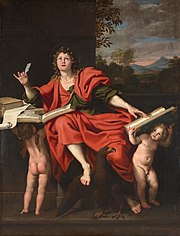
Back Openbaring Afrikaans የዮሐንስ ራዕይ Amharic Ontynung ANG رؤيا يوحنا Arabic ܓܠܝܢܐ ܕܝܘܚܢܢ ARC رؤيا يوحنا ARZ Apocalipsis AST Vəhy Kitabı Azerbaijani Offnbarung vom Johannes BAR Buku Pangungkapon BBC
| Part of a series on |
| Books of the New Testament |
|---|
 |
| Part of a series of articles on |
| John in the Bible |
|---|
 |
| Johannine literature |
| Authorship |
| Related literature |
| See also |
| Christian eschatology |
|---|
| Christianity portal |



The Book of Revelation or Book of the Apocalypse is the final book of the New Testament (and therefore the final book of the Christian Bible). Written in Koine Greek, its title is derived from the first word of the text: apokalypsis, meaning 'unveiling' or 'revelation'. The Book of Revelation is the only apocalyptic book in the New Testament canon.[a] It occupies a central place in Christian eschatology.
The author names himself as simply "John" in the text, but his precise identity remains a point of academic debate. Second-century Christian writers such as Papias of Hierapolis, Justin Martyr, Irenaeus, Melito of Sardis, Clement of Alexandria, and the author of the Muratorian fragment identify John the Apostle as the "John" of Revelation.[1][2] Modern scholarship generally takes a different view,[3] with many considering that nothing can be known about the author except that he was a Christian prophet.[4] Modern theological scholars characterize the Book of Revelation's author as "John of Patmos". The bulk of traditional sources date the book to the reign of the Roman emperor Domitian (AD 81–96), which evidence tends to confirm.[5][b]
The book spans three literary genres: the epistolary, the apocalyptic, and the prophetic.[7] It begins with John, on the island of Patmos in the Aegean Sea, addressing letters to the "Seven Churches of Asia". He then describes a series of prophetic visions, including figures such as the Seven-Headed Dragon, the Serpent, and the Beast, which culminate in the Second Coming of Jesus.
The obscure and extravagant imagery has led to a wide variety of Christian interpretations. Historicist interpretations see Revelation as containing a broad view of history while preterist interpretations treat Revelation as mostly referring to the events of the Apostolic Age (1st century), or, at the latest, the fall of the Western Roman Empire in the 5th century. Futurists, meanwhile, believe that Revelation describes future events with the seven churches growing into the body of believers throughout the age, and a reemergence or continuous rule of a Greco-Roman system with modern capabilities described by John in ways familiar to him; and idealist or symbolic interpretations consider that Revelation does not refer to actual people or events but is an allegory of the spiritual path and the ongoing struggle between good and evil.
Cite error: There are <ref group=lower-alpha> tags or {{efn}} templates on this page, but the references will not show without a {{reflist|group=lower-alpha}} template or {{notelist}} template (see the help page).
- ^ Carson, Don (2005). An Introduction to the New Testament (2nd ed.). Grand Rapids, Michigan: Zondervan. pp. 465ff. ISBN 978-0-310-51940-9.
- ^ Holmes, Michael (2007). The Apostolic Fathers: Greek Texts and English Translations. Baker Academic. p. 749ff. ISBN 978-0801034688.
- ^ Collins 1984, p. 28.
- ^ Bauckham 1993, p. 2.
- ^ Stuckenbruck 2003, pp. 1535–1536.
- ^ Behr, John (2019). John the Theologian and his Paschal Gospel. Oxford: Oxford University Press. ISBN 978-0-19-257444-2.
- ^ Stuckenbruck 2003, p. 1536.
© MMXXIII Rich X Search. We shall prevail. All rights reserved. Rich X Search